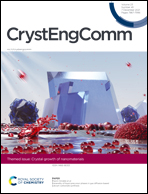Effects of growth substrate on the nucleation of monolayer MoTe2†
Abstract
The discovery and characterization of two-dimensional (2D) materials beyond graphene has increased dramatically over the past decade with increasingly fine control over the growth dynamics of these materials. MoTe2 represents a model material for studying phase change properties of 2D materials due to small energy differences between its 2H semiconducting phase and 1T′ semimetallic phase. Although some substrates are demonstrated to be better than others for the wafer-scale growth of high quality MoTe2 films, substrate effects on the nucleation and growth of MoTe2 are still not well understood. Here, we grow monolayer MoTe2 by converting MoOx thin films deposited on three different substrates: sapphire Al2O3 (0001), amorphous SiO2, and amorphous AlOx, and examine the early stages of the conversion reaction to elucidate the substrate effects on the nucleation of MoTe2. We observe that the chemical composition of the substrate is more important than the surface topography and crystallinity of the substrate, with high quality monolayer 2H MoTe2 formed on both Al2O3 (0001) and AlOx in contrast to mixed phase 2H/1T′ MoTe2 formed on SiO2, as determined by Raman spectroscopy, X-ray photoelectron spectroscopy, and atomic force microscopy.

- This article is part of the themed collections: Nanomaterials and Crystal growth of nanomaterials


 Please wait while we load your content...
Please wait while we load your content...